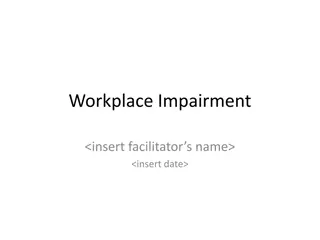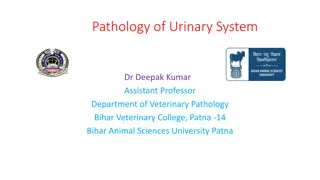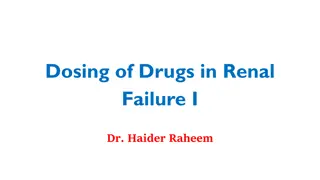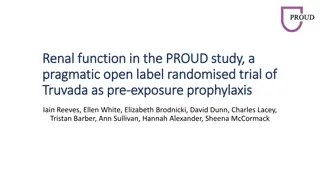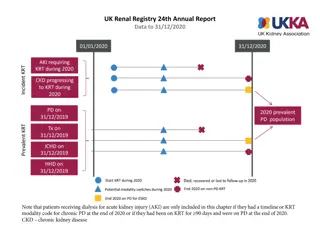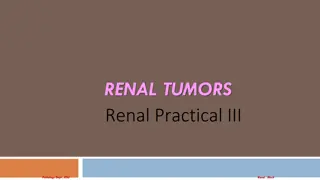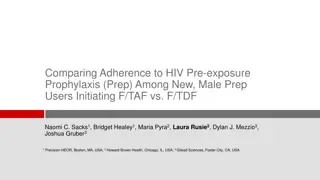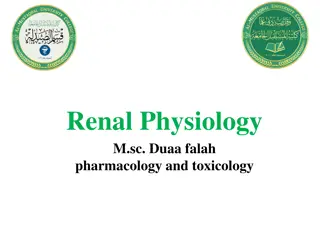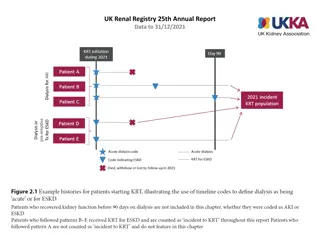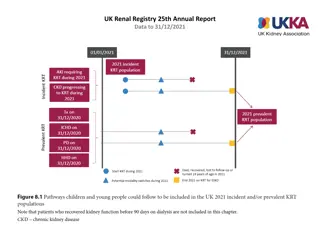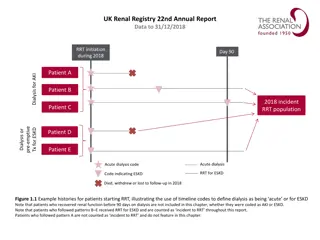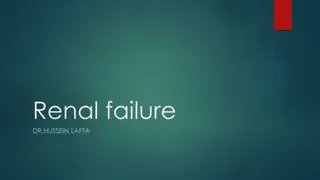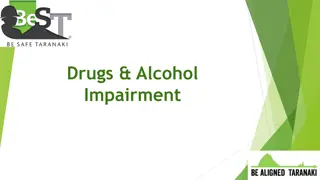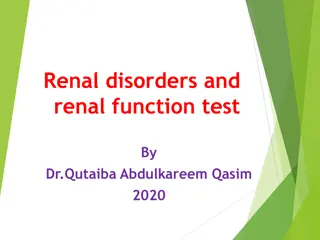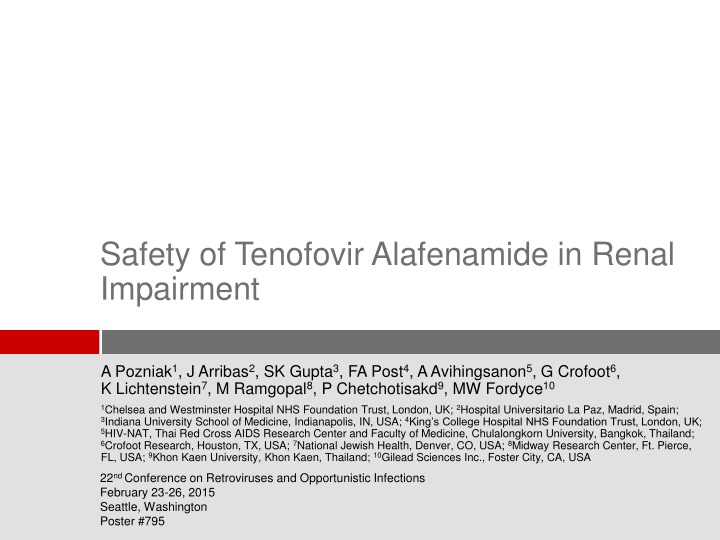
Safety of Tenofovir Alafenamide in Renal Impairment
Tenofovir Alafenamide (TAF) is a novel prodrug associated with renal and bone toxicity. This study evaluates its safety and efficacy in HIV-1 infected patients with mild to moderate renal impairment. Results suggest lower toxicity compared to TDF, making it promising for patients with renal issues.
Download Presentation

Please find below an Image/Link to download the presentation.
The content on the website is provided AS IS for your information and personal use only. It may not be sold, licensed, or shared on other websites without obtaining consent from the author. If you encounter any issues during the download, it is possible that the publisher has removed the file from their server.
You are allowed to download the files provided on this website for personal or commercial use, subject to the condition that they are used lawfully. All files are the property of their respective owners.
The content on the website is provided AS IS for your information and personal use only. It may not be sold, licensed, or shared on other websites without obtaining consent from the author.
E N D
Presentation Transcript
Safety of Tenofovir Alafenamide in Renal Impairment A Pozniak1, J Arribas2, SK Gupta3, FA Post4, A Avihingsanon5, G Crofoot6, K Lichtenstein7, M Ramgopal8, P Chetchotisakd9, MW Fordyce10 1Chelsea and Westminster Hospital NHS Foundation Trust, London, UK; 2Hospital Universitario La Paz, Madrid, Spain; 3Indiana University School of Medicine, Indianapolis, IN, USA; 4King s College Hospital NHS Foundation Trust, London, UK; 5HIV-NAT, Thai Red Cross AIDS Research Center and Faculty of Medicine, Chulalongkorn University, Bangkok, Thailand; 6Crofoot Research, Houston, TX, USA; 7National Jewish Health, Denver, CO, USA; 8Midway Research Center, Ft. Pierce, FL, USA; 9Khon Kaen University, Khon Kaen, Thailand; 10Gilead Sciences Inc., Foster City, CA, USA 22nd Conference on Retroviruses and Opportunistic Infections February 23-26, 2015 Seattle, Washington Poster #795
Tenofovir Alafenamide (TAF, GS-7340) Novel Prodrug of Tenofovir TDF has been associated with clinically significant renal and bone toxicity1-3 Patients with estimated glomerular filtration rate (eGFR) <50 mL/min require dose adjustment Patients with eGFR <70 mL/min should not initiate Stribald (elvitegravir/cobicistat/emtricitabine/TDF [E/C/F/TFD]) 1. 2. 3. DeJesus E, et al. Lancet 2012;379:2429-38 Gallant JE, et al. J Infect Dis 2013;208:32-39 Sax PE, et al. Lancet 2012;379:2439-48 2 Pozniak, et al. CROI, 2015, #795
Tenofovir Alafenamide (TAF, GS-7340) Novel Prodrug of Tenofovir (cont d) Relative to TDF 300 mg, TAF at an equivalent dose of 25 mg has 90% lower circulating plasma TFV, while maintaining high antiviral activity4 In 2 randomized, blinded, Phase 3 studies of E/C/F/TAF vs E/C/F/TDF: E/C/F/TAF was noninferior to E/C/F/TDF5 Prespecified renal and bone safety endpoints (hip bone mineral density [BMD], spine BMD, serum creatinine, and treatment-emergent proteinuria) showed significantly less change with E/C/F/TAF compared with E/C/F/TDF6 4. 5. 6. Ruane P, et al. J Acquir Immune Defic Syndr 2013; 63:449-5 Wohl D, et al. CROI 2015, Abstract 113LB Sax P, et al. CROI 2015, Abstract 143LB 3 Pozniak, et al. CROI, 2015, #795
Objective To evaluate safety and efficacy of a once-daily, single-tablet regimen of E/C/F/TAF in HIV-1 infected patients with mild to moderate renal impairment 4 Pozniak, et al. CROI, 2015, #795
Study Design Phase 3, 96-week, multicenter, open-label study (NCT01818596) Virologically suppressed adults with stable eGFRCG (30 69 mL/min) switched from TDF- or non-TDF containing regimens to open-label E/C/F/TAF Week 48 efficacy and safety data are described, including tests of renal function and BMD Actual GFR (aGFR) was assessed with iohexol clearance in a patient subset *eGFR measured using Cockcroft-Gault formula (eGFRCG) in all patients. Actual GFR measured using iohexol plasma clearance (CLiohexol) in a subset of patients at 3 time points: baseline; Week 2, 4, or 8; and Week 24. 5 Pozniak, et al. CROI, 2015, #795
Methods (contd) Key Inclusion Criteria CD4 cell count 50 cells/ L No chronic hepatitis B or C virus infection HIV-1 RNA HIV-suppressed patients: <50 copies/mL for 6 months Primary Safety Endpoint Change from baseline in eGFR at Week 24 Secondary Endpoints Efficacy, safety, and tolerability through Week 48 Proportion of patients with HIV-1 RNA <50 copies/mL 6 Pozniak, et al. CROI, 2015, #795
Baseline Characteristics Baseline eGFR Total N = 242 < 50 mL/min n=80 59 (52, 66) 50 mL/min n=162 58 (51, 64) 58 (52, 65) Median age, year (IQR) 25 (31) 38 (23) 63 (26) Age 65 years, n (%) 21 (26) 29 (18) 50 (21) Female, n (%) 18 98 622 58 50 15 43 19 98 635 69 34 13 60 18 98 632 65 39 14 56 Black or African descent, % HIV-1 RNA <50 copies/mL, % Median CD4 count, cells/ L Pre-switch TDF use, % Hypertension, % Diabetes, % Median eGFRCG, mL/min Median eGFRCKD-EPI, creatinine, mL/min/1.73 m2* 45 58 54 57 77 70 Median eGFRCKD-EPI, cystatin C, mL/min/1.73 m2 Dipstick proteinuria Grade 1 or 2, % Clinically significant proteinuria, % Clinically significant albuminuria, % 44 56 64 27 35 42 33 42 49 *Chronic Kidney Disease Epidemiology Collaboration equation for eGFR using serum creatinine (eGFRCKD-EPI, creatinine); adjusted for age, sex, and race. CKD-EPI equation for eGFR using cystatin C (eGFRCKD-EPI, cystatin C); adjusted for age and sex. Grade 1 (1+ on dipstick), Grade 2 (2 3+ on dipstick). Urine protein:creatinine (UPCR) >200 mg/g. Urine albumin:creatinine (UACR, ie, microalbuminuria) 30 mg/g. 7 Pozniak, et al. CROI, 2015, #795
Antiretroviral Treatment Prior to Switching to E/C/F/TAF *Some regimens included >1 third agent; therefore, total percentage >100%. 8 Pozniak, et al. CROI, 2015, #795
Change in eGFR From Baseline to Week 48 At Week 24, median (Q1, Q3) change from baseline in eGFRCG was -0.4 (-4.8, 4.5) mL/min, and in eGFRCKD-EPI, cystatin C was 3.8 (-4.8, 11.2) mL/min/1.73 m2 There was no significant change in eGFRCG or eGFRCKD-EPI, cystatin C to Week 48 9 Pozniak, et al. CROI, 2015, #795
Actual GFR by Iohexol Clearance (n=32) CI, confidence interval; GLSM, geometric least squares mean. Predefined lack of alteration boundary defined as 80 125% (GLSM) Actual GFR was not affected over 24 weeks of treatment No difference between patients with baseline eGFRCG<50 vs 50 mL/min, or between those taking TDF vs non-TDF containing regimens before switching to E/C/F/TAF (data not shown) 10 Pozniak, et al. CROI, 2015, #795
Proteinuria and Albuminuria Change From Baseline at Week 48 *Urine dipstick was used; 33% of patients (79/242) had proteinuria at baseline. Patients with non-missing values at both baseline and Week 48. Improved proteinuria = baseline Grade 1 Grade 0, or baseline Grade 2 Grade 1 or 0. Worsened proteinuria = baseline Grade 0 Grade 1, or baseline Grade 1 Grade 2. 11 Pozniak, et al. CROI, 2015, #795
Proteinuria and Albuminuria Change From Baseline at Week 48 (cont d) Most patients with dipstick proteinuria at baseline improved Decreased prevalence of clinically significant proteinuria and albuminuria *Significant median decrease from baseline to Week 48 by two-sided Wilcoxon signed-rank test (p <0.001). Improved = change from clinically significant UPCR (>200 mg/g) or UACR ( 30 mg/g) to nonsignificant UPCR or UACR. Worsened = change from nonsignificant to clinically significant UPCR or UACR. UACR, urine albumin:creatinine ratio; UPCR, urine protein:creatinine ratio. 12 Pozniak, et al. CROI, 2015, #795
Measures of Renal Tubular Function 2MG, beta-2 microglobulin/creatinine ratio; RBP, retinol binding protein. Significant improvements in urine retinol binding protein/creatinine ratio, beta-2 microglobulin/creatinine ratio, and fractional excretion of uric acid levels were observed (p <0.001 for all) *Significant change from baseline by two-sidedWilcoxon signed-rank test; p <0.001. TmP/GFR, ratio of tubular maximum reabsorption of phosphate (TmP) to GFR. 13 Pozniak, et al. CROI, 2015, #795
Change in Spine and Hip Bone Mineral Density *Two-sided Wilcoxon signed-rank test. 14 Pozniak, et al. CROI, 2015, #795
Change in Spine and Hip Bone Mineral Density (contd) Median percentage changes (Q1, Q3) in hip and spine BMD from baseline to Week 48 were 0.9% (-0.3, 2.7) and 1.9% (-0.3, 4.3), respectively 15 Pozniak, et al. CROI, 2015, #795
Metabolic Changes at Week 48 Fasting lipid levels decreased in patients who used non-TDF-containing regimens prior to switching to E/C/F/TAF, whereas levels increased in those using TDF-containing regimens prior to switching to E/C/F/TAF 16 Pozniak, et al. CROI, 2015, #795
Virologic Outcomes at Week 48 (by FDA snapshot) 92% (222 patients) maintained HIV-1 viral load <50 copies/mL at Week 48 7% (17 patients), virologic data not available 7 patients discontinued due to adverse events (AEs) by Week 48: renal failure (see next column), diarrhea, choking, fatigue/pain/pruritus, arthralgia/joint swelling, sleep disorder, bladder cancer After Week 48, 1 patient died (cardiopulmonary arrest), and 1 additional patient discontinued due to chronic renal failure (see next column) 7 patients discontinued due to other reasons and last available HIV-1 RNA <50 copies/mL (lost to follow-up, noncompliance, protocol violation, or discontinued by sponsor) 3 patients had missing data in the Week 48 window 17 Pozniak, et al. CROI, 2015, #795
Virologic Outcomes at Week 48 (by FDA snapshot) 1% (3 patients) had virologic failure 2 patients showed resistance 1 patient with HIV-1 RNA <50 copies/mL on E/C/F/TAF prior to switching to new regimen 1 patient with HIV-1 RNA <400 copies/mL on E/C/F/TAF; NRTI and PI resistance identical to pre-study historical genotype 1 patient took additional antiretrovirals (rilpivirine/emtricitabine/TDF) through Day 67 (protocol violation) Now on E/C/F/TAF alone with HIV-1 RNA <50 copies/mL through Week 48 18 Pozniak, et al. CROI, 2015, #795
Adverse Events in 5% of Patients to Week 48 Baseline eGFR < 50 mL/min n=80 13 8 3 9 11 6 3 5 4 10 5 6 5 Total N = 242 50 mL/min n=162 11 10 12 8 7 9 9 8 8 4 6 6 6 Patients, % Diarrhea Arthralgia Upper respiratory tract infection Bronchitis Osteopenia* Nausea Headache Pain in extremity Back pain Dizziness Fatigue Renal cyst Cough 11 9 9 8 8 8 7 7 7 6 6 6 6 *Of 19 patients, 16 had osteopenia at baseline; the other 3 had an AE of osteopenia reported within 12 days after switching to E/C/F/TAF. 19 Pozniak, et al. CROI, 2015, #795
Adverse Events in 5% of Patients to Week 48 (contd) Diarrhea (9%), arthralgia (8%), and bronchitis (8%) were the most commonly reported adverse events Adverse events, grades, and frequencies were similar in patients with baseline eGFR <50 vs 50 mL/min 2 patients (0.8%) discontinued study drug for decreased GFR by eGFRCG and eGFRCKD-EPI, cystatin C, neither with evidence of renal tubulopathy 1 patient with labile hypertension assessed as possibly related to concomitant ramipril and valsartan use and study drug 1 patient assessed as likely related to progression of hypertension- related chronic kidney disease and not related to study drug No patient developed proximal renal tubulopathy or Fanconi syndrome 20 Pozniak, et al. CROI, 2015, #795
Conclusions This is the first study of a single-tablet antiretroviral regimen without dose adjustment in patients with eGFR between 30 and 69 mL/min, in which the median baseline age is 58 years 92% of patients maintained HIV-1 RNA <50 copies/mL at Week 48 Switching to E/C/F/TAF was associated with no change in actual GFR, reductions in proteinuria and markers of proximal renal tubular function, and improvements in hip and spine bone mineral density Adverse events, grades, and frequencies were similar in patients with baseline eGFR <50 vs 50 mL/min These 48-week data support the virologic efficacy and renal and bone safety of once daily, single-tablet E/C/F/TAF therapy for patients with HIV and mild to moderate renal impairment (eGFR 30 69 mL/min) 21 Pozniak, et al. CROI, 2015, #795
Acknowledgments The authors gratefully acknowledge the investigators, study staff, and all participating patients of study GS-US-292-0112. This study was funded by Gilead Sciences, Inc. 22 Pozniak, et al. CROI, 2015, #795
Study Investigators J Andrade-Villanueva, J Arribas, A Avihingsanon, J Bartczak, P Benson, M Bloch, R Bolan, I Brar, F Bredeek, T Campbell, K Casey, P Chetchotisakd, A Clarke, C Cohen, L Cotte, G Crofoot, D Cunningham, C Dietz, R Dretler, C Fichtenbaum, D Fish, J Flamm, S Follansbee, F Garcia, J Gathe, R Grossberg, S Gupta, T Hawkins, K Henry, T Jefferson, R Kalayjian, C Katlama, S Kerkar, A Khalsa, S Kiertiburanakul, D Klein, E Koenig, S Lewis, K Lichtenstein, C Martorell, C McDonald, J McGowan, J McMahon, A Mills, T Mudrikova, E Negredo, O Osiyemi, P Palmieri, D Podzamczer, F Post, A Pozniak, D Prelutsky, M Ramagopal, W Ratanasuwan, G Richmond, W Robbins, N Roth, P Ruane, A Scarsella, G Schembri, S Schneider, P Shalit, W Short, J Slim, L Sloan, D Stein, J Stephens, P Tebas, D Ward, T Wills. 23 Pozniak, et al. CROI, 2015, #795




